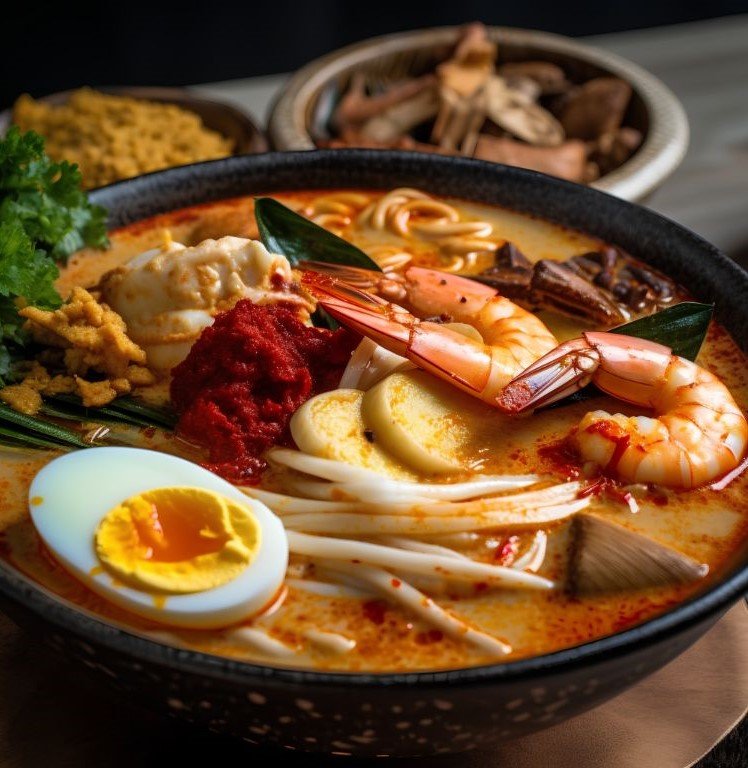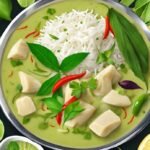The Origin of Tom Yum Goong
Tom Yum Goong, a classic Thai dish, has its roots deeply embedded in the rich tapestry of Thai culinary traditions. This iconic soup, known for its distinctive hot and sour flavors, is believed to have originated from the central region of Thailand, where culinary practices emphasize the harmonious balance of flavors. The term “Tom Yum” itself translates to “boiling” (Tom) and “spicy and sour” (Yum), perfectly encapsulating the essence of this flavorful dish.
The historical background of Tom Yum Goong traces back to the early 20th century, when the recipe began to evolve from its simple origins. Traditionally, the dish was made using fresh seafood, particularly shrimp (Goong), combined with a fragrant blend of herbs and spices such as lemongrass, kaffir lime leaves, galangal, and bird’s eye chili. Over time, variations emerged, influenced by the availability of local ingredients and regional tastes. As a result, different provinces in Thailand now boast their unique takes on this beloved soup, integrating local produce, seafood, and techniques.
Culturally, Tom Yum Goong has transcended its status as merely a dish to become a symbol of Thai identity. It reflects the ingenuity of Thai chefs in creating recipes that showcase fresh ingredients and traditional flavors. The dish has gained significant global popularity, prompting chefs outside Thailand to experiment with various interpretations of the classic Thai Tom Yum Goong recipe. Modern influences have also introduced fusion versions that incorporate elements from other cuisines, further expanding the dish’s reach. Overall, Tom Yum Goong remains a cherished culinary artifact, illustrating Thailand’s rich gastronomic heritage and its ability to adapt and thrive in diverse cultural landscapes.
Ingredients that Make Tom Yum Goong Unique
Tom Yum Goong, a celebrated dish in Thailand food culture, is renowned for its bold and complex flavors, primarily derived from a harmonious combination of fresh herbs and seafood. Central to this delectable soup are ingredients such as lemongrass, kaffir lime leaves, and galangal, each contributing unique aromatic properties. Lemongrass brings a citrusy zest, enhancing the dish’s freshness, while kaffir lime leaves impart a distinctive fragrance that elevates the overall taste. Galangal, often compared to ginger, adds a subtle spiciness and warmth, further enriching the flavor profile of this iconic Thailand food.
The primary protein in traditional tom yum goong is shrimp, which not only offers a sweet and briny essence but also absorbs the soup’s fragrant elements during cooking. The use of fresh, high-quality seafood is crucial, as it significantly influences the dish’s overall appeal. Variations of tom yum can include alternative proteins such as fish, squid, or even tofu, accommodating diverse dietary preferences and ingredient availability. These substitutions can slightly alter the flavor but still result in a delicious and enjoyable bowl of soup.
The balance of spices is another key factor in crafting a perfect tom yum goong. Commonly, chili peppers provide the necessary heat, but the spice level can be adjusted according to personal taste, making this dish versatile for all palates. Additionally, ingredients such as mushrooms and fresh vegetables can be incorporated to enhance the nutritional value and create a satisfying meal. Ultimately, the elegance of a thai tom yum goong recipe lies in the interplay of these ingredients, showcasing the rich culinary traditions of Thailand while allowing for customization based on individual preferences.
Cooking Techniques for the Perfect Tom Yum Goong

Cooking Tom Yum Goong, a renowned Thai dish, requires careful attention to technique to capture its signature flavors. First and foremost, the preparation and cleaning of the seafood are essential. Typically, fresh shrimp is the primary ingredient; however, squid and fish can also be utilized. Begin by thoroughly rinsing the seafood under cold water to remove any unwanted grit or impurities. For shrimp, it is advisable to remove the shell and the intestinal tract, as this will enhance the dish’s overall texture and flavor. Ensuring the seafood is fresh is paramount for achieving the authentic taste attributed to Thailand food, especially in Tom Yum Goong.
The next critical step is balancing the prominent flavors of tartness and spiciness, characteristic of a good Thai Tom Yum Goong recipe. Start with a fragrant broth by boiling water with galangal, lemongrass, kaffir lime leaves, and Thai bird’s eye chili peppers. This combination creates a rich and aromatic base. As the broth simmers, integrating fish sauce and fresh lime juice will elevate the dish’s flavor profile, making it tangy and savory. It is crucial to taste the broth intermittently, adjusting the seasonings to achieve a harmonious balance.
When cooking the seafood, remember that timing is essential; overcooking can lead to a rubbery texture. Typically, shrimp should be added last, cooking just until they turn pink and opaque, which usually takes only a few minutes. It is also advisable to avoid overcrowding the pot, as this can alter cooking times and the overall temperature. By being mindful of these techniques and avoiding common mistakes—such as neglecting to taste and adjust seasoning—one can successfully recreate this iconic Thailand food dish that embodies the complexity of flavors of Tom Yum Goong.
Serving and Enjoying Tom Yum Goong

Tom Yum Goong is not only a dish renowned for its bold and aromatic flavors, but it is also celebrated for the social experience it fosters among those who partake in its enjoyment. Traditionally served in a communal style, this shrimp soup invites diners to gather around, share stories, and indulge in the vibrant flavors of Thailand food. This sense of togetherness is an integral part of enjoying Tom Yum Goong, making it more than just a meal; it becomes a celebration.
When it comes to presentation, Tom Yum Goong is typically served steaming hot, often accompanied by fresh herbs like cilantro and lime wedges which contribute to its visual appeal. The dish is frequently garnished with aromatic ingredients such as kaffir lime leaves and mushrooms, enhancing both its flavor and appearance. These components create an inviting table setting that immediately draws attention and stimulates the appetite of those seated around it.
To elevate the dining experience, pairing Tom Yum Goong with a variety of side dishes can be advantageous. Sticky rice is a popular accompaniment, as it serves to balance the dish’s spiciness and tartness. Additionally, fresh spring rolls or fried tofu can provide a satisfying contrast to the soup’s intense flavors. When considering beverages, a light Thai beer or a refreshing iced tea can complement the heat of Tom Yum Goong, enriching the overall experience as one savors every bite.
In summary, enjoying Tom Yum Goong transcends mere consumption; it is about sharing, connection, and appreciation of the culinary tradition that it represents. The way it is served and the company kept enhance the flavors of this iconic dish, making each dining experience memorable and enjoyable. Whether at home or in a bustling market in Thailand, the enjoyment of Tom Yum Goong is best shared, reflecting the heart of Thai cuisine and culture.


